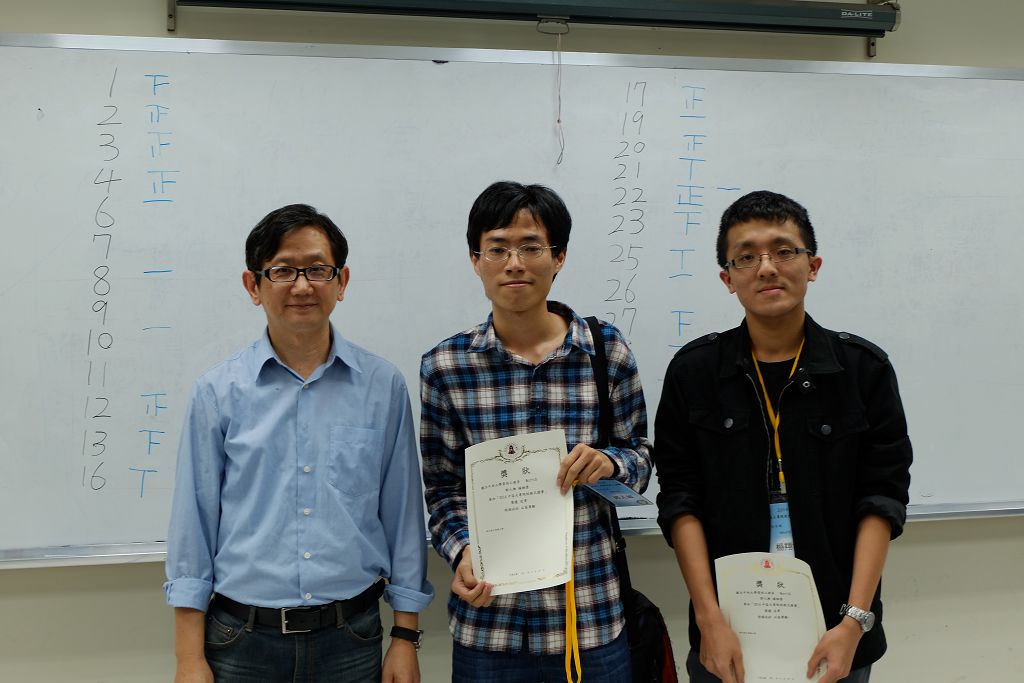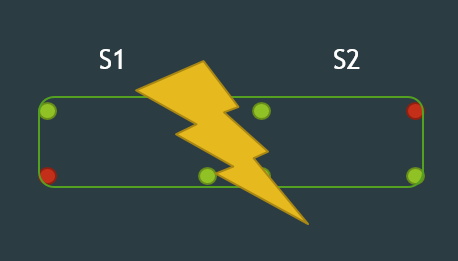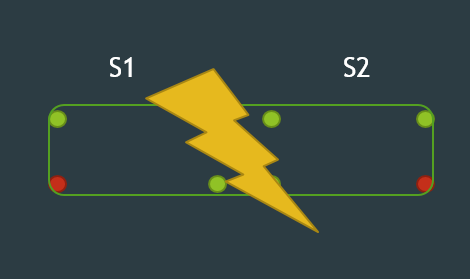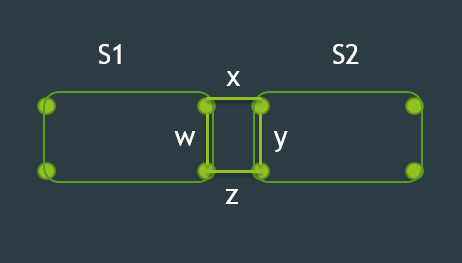#include <stdio.h>
#include <algorithm>
#include <map>
#include <iostream>
#include <vector>
#include <string.h>
using namespace std;
class Info {
public:
static int M, N, R, K, T;
static map<string, int> HP, ATK;
static string Mkind[];
static string Rkind[];
static string Bkind[];
};
int Info::M = 0, Info::N = 0, Info::R = 0, Info::K = 0, Info::T = 0;
map<string, int> Info::HP, Info::ATK;
string Info::Mkind[] = {"dragon", "ninja", "iceman", "lion", "wolf"};
string Info::Rkind[] = {"dragon", "iceman", "lion", "wolf", "ninja"};
string Info::Bkind[] = {"wolf", "lion", "dragon", "ninja", "iceman"};
class Weapon {
public:
virtual void show() {};
virtual int getMeleeAttack() {
return 0;
};
virtual int actMeleeAttack() {
return 0;
};
virtual int getRangeAttack() {
return 0;
}
virtual int actRangeAttack() {
return 0;
}
virtual int getBombAttack() {
return 0;
}
virtual int actBombAttack() {
return 0;
}
};
class Sword: public Weapon {
public:
int attack;
Sword(int _attack): attack(_attack) {
}
int getMeleeAttack() {
return attack;
}
int actMeleeAttack() {
attack = attack * 8 / 10;
return attack > 0;
}
void show() {
printf("sword(%d)", attack);
}
};
class Arrow: public Weapon {
public:
int R, usedTime;
Arrow(int _R): R(_R) {
usedTime = 0;
}
int getRangeAttack() {
return usedTime < 3 ? R : 0;
}
int actRangeAttack() {
usedTime++;
return usedTime >= 3;
}
void show() {
printf("arrow(%d)", 3 - usedTime);
}
};
class Bomb: public Weapon {
public:
Bomb() {
}
int getBombAttack() {
return 1;
}
void show() {
printf("bomb");
}
};
class WeaponFactory {
public:
static Weapon* build(int n, int attack) {
if(n == 0) {
if(attack / 5 <= 0)
return NULL;
return new Sword(attack/5);
}
else if(n == 2)
return new Arrow(Info::R);
else
return new Bomb();
}
};
class Warrior {
public:
int n;
int life;
Warrior(int _n, int _life): n(_n), life(_life) {
}
virtual void show() {};
virtual void showName() {};
virtual void showWeapon() {};
virtual int getAttack() {return 0;}
virtual int getFled() {return 0;}
virtual int getMeleeAttack() {return 0;}
virtual void actMeleeAttack() {}
virtual int getBackAttack() {return 0;}
virtual void actBackAttack() {}
virtual void move() {};
virtual void actRangeAttack(Warrior* o) {};
};
class Dragon: public Warrior {
public:
Weapon *weapon;
float morale;
Dragon(int _n, int _life, float _morale): Warrior(_n, _life), morale(_morale) {
weapon = WeaponFactory::build(n%3, Info::ATK["dragon"]);
}
void show() {
printf("dragon %d born\n", n);
printf("Its morale is %.2f\n", morale);
}
void showName() {
printf("dragon %d", n);
}
void showWeapon() {
if(weapon != NULL)
weapon->show();
else
printf("no weapon");
}
int getAttack() {
return Info::ATK["dragon"];
}
int getMeleeAttack() {
int m = 0;
if(weapon != NULL)
m = weapon->getMeleeAttack();
return getAttack() + m;
}
int getBackAttack() {
int m = 0;
if(weapon != NULL)
m = weapon->getMeleeAttack();
return getAttack()/2 + m;
}
void actMeleeAttack() {
if(weapon != NULL) {
int f = weapon->actMeleeAttack();
if(f == 0) {
delete weapon;
weapon = NULL;
}
}
}
void actBackAttack() {
actMeleeAttack();
}
void actRangeAttack(Warrior* o) {
if(weapon != NULL) {
o->life -= weapon->getRangeAttack();
int f = weapon->actRangeAttack();
if(f == 1) {
delete weapon;
weapon = NULL;
}
}
}
};
class Ninja: public Warrior {
public:
Weapon *weapon[2];
Ninja(int _n, int _life): Warrior(_n, _life) {
weapon[0] = WeaponFactory::build(n%3, Info::ATK["ninja"]);
weapon[1] = WeaponFactory::build((n+1)%3, Info::ATK["ninja"]);
}
void show() {
printf("ninja %d born\n", n);
}
void showName() {
printf("ninja %d", n);
}
void showWeapon() {
int f1 = n%3, f2 = (n+1)%3, f = 0;
if(f1 < f2) {
if(weapon[0] != NULL)
weapon[0]->show(), f++;
if(f) putchar(',');
if(weapon[1] != NULL)
weapon[1]->show(), f++;
} else {
if(weapon[1] != NULL)
weapon[1]->show(), f++;
if(f) putchar(',');
if(weapon[0] != NULL)
weapon[0]->show(), f++;
}
if(f == 0)
printf("no weapon");
}
int getAttack() {
return Info::ATK["ninja"];
}
int getMeleeAttack() {
int m = 0;
if(weapon[0] != NULL)
m += weapon[0]->getMeleeAttack();
if(weapon[1] != NULL)
m += weapon[1]->getMeleeAttack();
return getAttack() + m;
}
int getBackAttack() {
int m = 0;
if(weapon[0] != NULL)
m += weapon[0]->getMeleeAttack();
if(weapon[1] != NULL)
m += weapon[1]->getMeleeAttack();
return getAttack()/2 + m;
}
void actMeleeAttack() {
if(weapon[0] != NULL) {
int f = weapon[0]->actMeleeAttack();
if(f == 0) {
delete weapon[0];
weapon[0] = NULL;
}
}
if(weapon[1] != NULL) {
int f = weapon[1]->actMeleeAttack();
if(f == 0) {
delete weapon[1];
weapon[1] = NULL;
}
}
}
void actBackAttack() {
actMeleeAttack();
}
void actRangeAttack(Warrior* o) {
for(int i = 0; i < 2; i++) {
if(weapon[i] != NULL) {
o->life -= weapon[i]->getRangeAttack();
int f = weapon[i]->actRangeAttack();
if(f == 1)
weapon[i] = NULL;
}
}
}
};
class Iceman: public Warrior {
public:
Weapon *weapon;
int move_count;
int attack;
Iceman(int _n, int _life): Warrior(_n, _life) {
weapon = WeaponFactory::build(n%3, Info::ATK["iceman"]);
move_count = 0;
attack = Info::ATK["iceman"];
}
void show(){
printf("iceman %d born\n", n);
}
void showName() {
printf("iceman %d", n);
}
void showWeapon() {
if(weapon != NULL)
weapon->show();
else
printf("no weapon");
}
int getAttack() {
return attack;
}
int getMeleeAttack() {
int m = 0;
if(weapon != NULL)
m = weapon->getMeleeAttack();
return getAttack() + m;
}
int getBackAttack() {
int m = 0;
if(weapon != NULL)
m = weapon->getMeleeAttack();
return getAttack()/2 + m;
}
void actMeleeAttack() {
if(weapon != NULL) {
int f = weapon->actMeleeAttack();
if(f == 0) {
delete weapon;
weapon = NULL;
}
}
}
void actBackAttack() {
actMeleeAttack();
}
void actRangeAttack(Warrior* o) {
if(weapon != NULL) {
o->life -= weapon->getRangeAttack();
int f = weapon->actRangeAttack();
if(f == 1) {
delete weapon;
weapon = NULL;
}
}
}
void move() {
move_count++;
if(move_count == 2) {
attack += 20;
life -= 9;
if(life <= 0)
life = 1;
move_count = 0;
}
}
};
class Lion: public Warrior {
public:
int loyalty;
Lion(int _n, int _life, int _loyalty): Warrior(_n, _life), loyalty(_loyalty) {
}
void show() {
printf("lion %d born\n", n);
printf("Its loyalty is %d\n", loyalty);
}
void showName() {
printf("lion %d", n);
}
void showWeapon() {
printf("no weapon");
}
int getAttack() {
return Info::ATK["lion"];
}
int getMeleeAttack() {
return getAttack();
}
int getBackAttack() {
return getAttack()/2;
}
int getFled() {
return loyalty <= 0;
}
};
class Wolf: public Warrior {
public:
Weapon *weapon[3];
Wolf(int _n, int _life): Warrior(_n, _life) {
weapon[0] = weapon[1] = weapon[2] = NULL;
}
void show() {
printf("wolf %d born\n", n);
}
void showName() {
printf("wolf %d", n);
}
void showWeapon() {
int f = 0;
for(int i = 0; i < 3; i++) {
if(weapon[i] != NULL) {
if(f) putchar(',');
weapon[i]->show(), f++;
}
}
if(f == 0)
printf("no weapon");
}
int getAttack() {
return Info::ATK["wolf"];
}
int getMeleeAttack() {
int m = 0;
if(weapon[2] != NULL)
m = weapon[2]->getMeleeAttack();
return getAttack() + m;
}
int getBackAttack() {
int m = 0;
if(weapon[2] != NULL)
m = weapon[2]->getMeleeAttack();
return getAttack()/2 + m;
}
void actMeleeAttack() {
if(weapon[2] != NULL) {
int f = weapon[2]->actMeleeAttack();
if(f == 0) {
delete weapon[2];
weapon[2] = NULL;
}
}
}
void actBackAttack() {
actMeleeAttack();
}
void actRangeAttack(Warrior* o) {
if(weapon[2] != NULL) {
o->life -= weapon[2]->getRangeAttack();
int f = weapon[2]->actRangeAttack();
if(f == 1)
weapon[2] = NULL;
}
}
};
class WarriorFactory {
public:
static Warrior* build(string kind, int n, float _morale, int _loyalty) {
if(!strcmp(kind.c_str(), "dragon"))
return new Dragon(n, Info::HP[kind], _morale);
else if(!strcmp(kind.c_str(), "ninja"))
return new Ninja(n, Info::HP[kind]);
else if(!strcmp(kind.c_str(), "iceman"))
return new Iceman(n, Info::HP[kind]);
else if(!strcmp(kind.c_str(), "lion"))
return new Lion(n, Info::HP[kind], _loyalty);
else
return new Wolf(n, Info::HP[kind]);
}
};
class Headquarter {
public:
int HP;
int dir;
int n;
Headquarter(int _HP, int _dir): HP(_HP), dir(_dir) {
n = 1;
}
void produce(vector<Warrior*> R[], vector<Warrior*> B[], int hh, int mm) {
string kind;
int born_cost;
if(dir == 1) {
kind = Info::Rkind[n % 5];
} else {
kind = Info::Bkind[n % 5];
}
born_cost = Info::HP[kind];
if(born_cost > HP)
return;
HP -= born_cost;
printf("%03d:%02d %s ", hh, mm, dir == 1 ? "red" : "blue");
Warrior *w = WarriorFactory::build(kind, n, (double) HP/ Info::HP[kind], HP);
w->show();
if(dir == 1) {
R[0].push_back(w);
} else {
B[Info::N + 1].push_back(w);
}
n++;
}
};
void simulate() {
Headquarter RED(Info::M, 1), BLUE(Info::M, -1);
int timescale[] = {0, 5, 10, 20, 30, 35, 38, 40, 50, 55};
vector<Warrior*> R[Info::N + 2], B[Info::N + 2];
int cityHP[Info::N+2], cityFlag[Info::N+2], cityBattle[Info::N+2];
for(int i = 0; i <= Info::N + 1; i++)
cityHP[i] = cityFlag[i] = cityBattle[i] = 0;
for(int hour = 0; ; hour++) {
for(int i = 0; i < 10; i++) {
if(hour * 60 + timescale[i] > Info::T)
return;
int t = timescale[i];
if(t == 0) {
RED.produce(R, B, hour, t);
BLUE.produce(R, B, hour, t);
} else if(t == 5) {
for(int i = 0; i <= Info::N; i++) {
if(R[i].size() > 0) {
if(R[i][0]->getFled()) {
printf("%03d:%02d red ", hour, t);
R[i][0]->showName();
printf(" ran away\n");
R[i].clear();
}
}
}
for(int i = 1; i <= Info::N+1; i++) {
if(B[i].size() > 0) {
if(B[i][0]->getFled()) {
printf("%03d:%02d blue ", hour, t);
B[i][0]->showName();
printf(" ran away\n");
B[i].clear();
}
}
}
} else if(t == 10) {
for(int i = 0; i <= Info::N + 1; i++) {
if(R[i].size() > 0 && i <= Info::N) {
printf("%03d:%02d red ", hour, t);
R[i][0]->showName();
R[i][0]->move();
if(i + 1 < Info::N + 1)
printf(" marched to city %d with %d elements and force %d\n", i + 1, R[i][0]->life, R[i][0]->getAttack());
else
printf(" reached blue headquarter with %d elements and force %d\n", R[i][0]->life, R[i][0]->getAttack());
}
if(B[i].size() > 0 && i > 0) {
printf("%03d:%02d blue ", hour, t);
B[i][0]->showName();
B[i][0]->move();
if(i - 1 > 0)
printf(" marched to city %d with %d elements and force %d\n", i - 1, B[i][0]->life, B[i][0]->getAttack());
else
printf(" reached red headquarter with %d elements and force %d\n", B[i][0]->life, B[i][0]->getAttack());
}
}
for(int i = Info::N; i >= 0; i--) {
if(R[i].size() > 0) {
R[i+1].push_back(R[i][0]);
R[i].clear();
}
}
for(int i = 1; i <= Info::N + 1; i++) {
if(B[i].size() > 0) {
B[i-1].push_back(B[i][0]);
B[i].clear();
}
}
if(B[0].size() >= 2) {
printf("%03d:%02d red headquarter was taken\n", hour, t);
return ;
}
if(R[Info::N+1].size() >= 2) {
printf("%03d:%02d blue headquarter was taken\n", hour, t);
return ;
}
} else if(t == 20) {
for(int i = 1; i <= Info::N; i++)
cityHP[i] += 10;
} else if(t == 30) {
for(int i = 1; i <= Info::N; i++) {
if(R[i].size() == 1 && B[i].size() == 0) {
printf("%03d:%02d red ", hour, t);
R[i][0]->showName();
printf(" earned %d elements for his headquarter\n", cityHP[i]);
RED.HP += cityHP[i], cityHP[i] = 0;
}
if(R[i].size() == 0 && B[i].size() == 1) {
printf("%03d:%02d blue ", hour, t);
B[i][0]->showName();
printf(" earned %d elements for his headquarter\n", cityHP[i]);
BLUE.HP += cityHP[i], cityHP[i] = 0;
}
}
} else if(t == 35) {
for(int i = 0; i <= Info::N; i++) {
if(R[i].size() > 0 && B[i+1].size() > 0) {
R[i][0]->actRangeAttack(B[i+1][0]);
}
}
for(int i = 1; i <= Info::N + 1; i++) {
if(B[i].size() > 0 && R[i-1].size() > 0) {
B[i][0]->actRangeAttack(R[i-1][0]);
}
}
} else if(t == 38) {
for(int i = 0; i <= Info::N + 1; i++) {
if(R[i].size() > 0 && B[i].size() > 0) {
int rATK = R[i][0]->getMeleeAttack();
int bATK = B[i][0]->getMeleeAttack();
if(bATK >= R[i][0]->life) {
printf("%03d:%02d red ", hour, t);
R[i][0]->showName();
printf(" used a bomb and killed blue ");;
B[i][0]->showName();
puts("");
}
if(rATK >= B[i][0]->life) {
printf("%03d:%02d blue ", hour, t);
B[i][0]->showName();
printf(" used a bomb and killed red ");;
R[i][0]->showName();
puts("");
}
if(bATK >= R[i][0]->life || rATK >= B[i][0]->life) {
delete R[i][0];
R[i].clear();
delete B[i][0];
B[i].clear();
}
}
}
} else if(t == 40) {
int RB[Info::N+2];
for(int i = 1; i <= Info::N; i++) {
RB[i] = 0;
}
for(int i = 1; i <= Info::N; i++) {
if(R[i].size() > 0 && B[i].size() > 0) {
if(R[i][0]->life <= 0 || B[i][0]->life <= 0) {
} else {
if(cityFlag[i] == 1 || (cityFlag[i] == 0 && i%2 == 1)) {
int AT = R[i][0]->getMeleeAttack();
B[i][0]->life -= AT;
if(B[i][0]->life > 0) {
int BAT = B[i][0]->getBackAttack();
R[i][0]->life -= AT;
}
} else {
int AT = B[i][0]->getMeleeAttack();
R[i][0]->life -= AT;
if(R[i][0]->life > 0) {
int BAT = R[i][0]->getBackAttack();
B[i][0]->life -= AT;
}
}
}
if(R[i][0]->life > 0 && B[i][0]->life <= 0) {
RB[i] = 1;
if(cityBattle[i] == 1) {
cityFlag[i] = 1;
} else if(cityBattle[i] == 0) {
cityBattle[i] = 1;
}
}
if(B[i][0]->life > 0 && R[i][0]->life <= 0) {
RB[i] = 2;
if(cityBattle[i] == 2) {
cityFlag[i] = 2;
} else if(cityBattle[i] == 0) {
cityBattle[i] = 2;
}
}
}
if(R[i].size() > 0 && R[i][0]->life <= 0) {
delete R[i][0];
R[i].clear();
}
if(B[i].size() > 0 && B[i][0]->life <= 0) {
delete B[i][0];
B[i].clear();
}
}
for(int i = Info::N + 1; i >= 0; i--) {
if(RED.HP >= 8 && RB[i] == 1) {
RED.HP -= 8;
R[i][0]->life += 8;
}
}
for(int i = 0; i <= Info::N + 1; i++) {
if(BLUE.HP >= 8 && RB[i] == 2) {
BLUE.HP -= 8;
B[i][0]->life += 8;
}
}
for(int i = 0; i <= Info::N + 1; i++) {
if(RB[i] == 1) {
RED.HP += cityHP[i];
cityHP[i] = 0;
}
if(RB[i] == 2) {
BLUE.HP += cityHP[i];
cityHP[i] = 0;
}
}
} else if(t == 50) {
printf("%03d:%02d %d elements in red headquarter\n", hour, t, RED.HP);
printf("%03d:%02d %d elements in blue headquarter\n", hour, t, BLUE.HP);
} else if(t == 55) {
for(int i = 0; i <= Info::N + 1; i++) {
if(R[i].size() == 1) {
printf("%03d:%02d red ", hour, t);
R[i][0]->showName();
printf(" has ");
R[i][0]->showWeapon();
puts("");
}
if(B[i].size() == 1) {
printf("%03d:%02d blue ", hour, t);
B[i][0]->showName();
printf(" has ");
B[i][0]->showWeapon();
puts("");
}
}
}
}
}
}
int main() {
freopen("in.txt", "r+t", stdin);
freopen("out-my.txt", "w+t", stdout);
int testcase, cases = 0;
scanf("%d", &testcase);
while(testcase--) {
scanf("%d %d %d %d %d", &Info::M, &Info::N, &Info::R, &Info::K, &Info::T);
for(int i = 0; i < 5; i++)
scanf("%d", &Info::HP[Info::Mkind[i]]);
for(int i = 0; i < 5; i++)
scanf("%d", &Info::ATK[Info::Mkind[i]]);
printf("Case %d:\n", ++cases);
simulate();
}
return 0;
}







